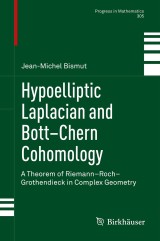Details

Hypoelliptic Laplacian and Bott-Chern Cohomology
A Theorem of Riemann-Roch-Grothendieck in Complex GeometryProgress in Mathematics, Band 305
|
85,59 € |
|
| Verlag: | Birkhäuser |
| Format: | |
| Veröffentl.: | 23.05.2013 |
| ISBN/EAN: | 9783319001289 |
| Sprache: | englisch |
Dieses eBook enthält ein Wasserzeichen.
Beschreibungen
The book provides the proof of a complex geometric version of a well-known result in algebraic geometry: the theorem of Riemann–Roch–Grothendieck for proper submersions. It gives an equality of cohomology classes in Bott–Chern cohomology, which is a refinement for complex manifolds of de Rham cohomology. When the manifolds are Kähler, our main result is known. A proof can be given using the elliptic Hodge theory of the fibres, its deformation via Quillen's superconnections, and a version in families of the 'fantastic cancellations' of McKean–Singer in local index theory. In the general case, this approach breaks down because the cancellations do not occur any more. One tool used in the book is a deformation of the Hodge theory of the fibres to a hypoelliptic Hodge theory, in such a way that the relevant cohomological information is preserved, and 'fantastic cancellations' do occur for the deformation. The deformed hypoelliptic Laplacian acts on the total space of the relative tangent bundle of the fibres. While the original hypoelliptic Laplacian discovered by the author can be described in terms of the harmonic oscillator along the tangent bundle and of the geodesic flow, here, the harmonic oscillator has to be replaced by a quartic oscillator. Another idea developed in the book is that while classical elliptic Hodge theory is based on the Hermitian product on forms, the hypoelliptic theory involves a Hermitian pairing which is a mild modification of intersection pairing. Probabilistic considerations play an important role, either as a motivation of some constructions, or in the proofs themselves.
Introduction.- 1 The Riemannian adiabatic limit.- 2 The holomorphic adiabatic limit.- 3 The elliptic superconnections.- 4 The elliptic superconnection forms.- 5 The elliptic superconnections forms.- 6 The hypoelliptic superconnections.- 7 The hypoelliptic superconnection forms.- 8 The hypoelliptic superconnection forms of vector bundles.- 9 The hypoelliptic superconnection forms.- 10 The exotic superconnection forms of a vector bundle.- 11 Exotic superconnections and Riemann–Roch–Grothendieck.- Bibliography.- Subject Index.- Index of Notation.
Jean-Michel Bismut is Professor of Mathematics at Université Paris-Sud (Orsay) and a member of the Académie des Sciences. Starting with a background in probability, he has worked extensively on index theory. With Gillet, Soulé, and Lebeau, he contributed to the proof of a theorem of Riemann–Roch–Grothendieck in Arakelov geometry. More recently, he has developed a theory of the hypoelliptic Laplacian, a family of operators that deforms the classical Laplacian, and provides a link between spectral theory and dynamical systems.
The book provides the proof of a complex geometric version of a well-known result in algebraic geometry: the theorem of Riemann–Roch–Grothendieck for proper submersions. It gives an equality of cohomology classes in Bott–Chern cohomology, which is a refinement for complex manifolds of de Rham cohomology. When the manifolds are Kähler, our main result is known. A proof can be given using the elliptic Hodge theory of the fibres, its deformation via Quillen's superconnections, and a version in families of the 'fantastic cancellations' of McKean–Singer in local index theory. In the general case, this approach breaks down because the cancellations do not occur any more. One tool used in the book is a deformation of the Hodge theory of the fibres to a hypoelliptic Hodge theory, in such a way that the relevant cohomological information is preserved, and 'fantastic cancellations' do occur for the deformation. The deformed hypoelliptic Laplacian acts on the total space of the relative tangent bundle of the fibres. While the original hypoelliptic Laplacian discovered by the author can be described in terms of the harmonic oscillator along the tangent bundle and of the geodesic flow, here, the harmonic oscillator has to be replaced by a quartic oscillator. Another idea developed in the book is that while classical elliptic Hodge theory is based on the Hermitian product on forms, the hypoelliptic theory involves a Hermitian pairing which is a mild modification of intersection pairing. Probabilistic considerations play an important role, either as a motivation of some constructions, or in the proofs themselves.
Gives an important application of the theory of the hypoelliptic Laplacian in complex algebraic geometry Provides an introduction to applications of Quillen's superconnections in complex geometry with hypoelliptic operators Presents several techniques partly inspired from physics, which concur to the proof of a result in complex algebraic geometry The method of hypoelliptic deformation of the classical Laplacian was developed by the author during the last ten years Includes supplementary material: sn.pub/extras

















